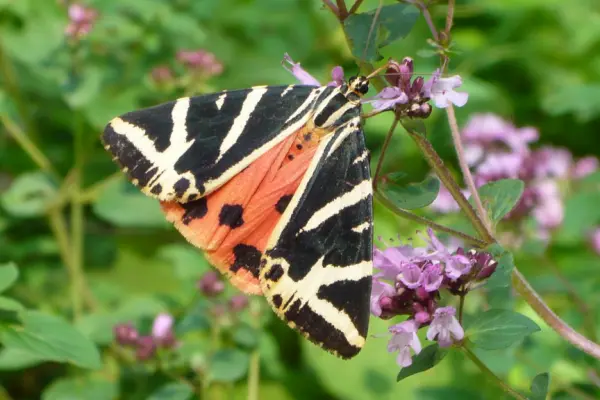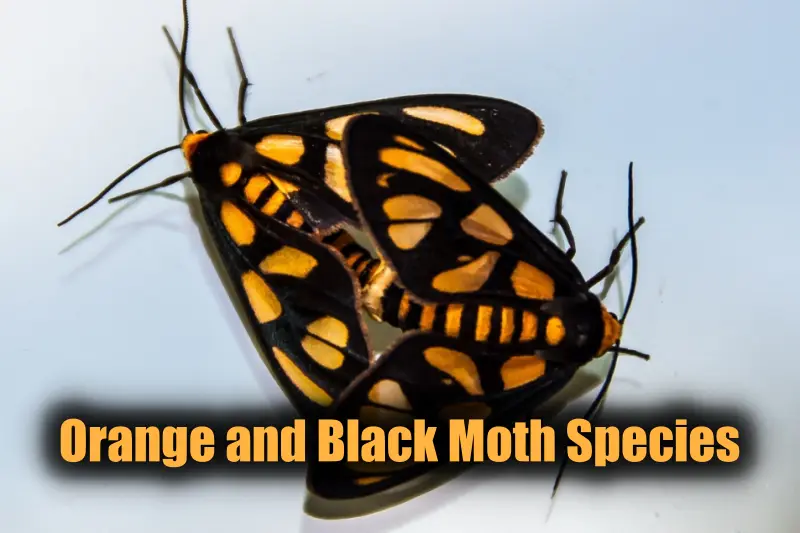The distinct orange and black color combination serves as nature’s ingenious defense mechanism, aiding creatures in evading their predators. This striking color pairing is a warning signal of the animal’s unpalatability and toxic nature, essentially conveying, ‘If you eat me, you die.’
Exploring nature’s defense strategies is always fascinating, shedding light on how it protects its members.
Much like our previous article on butterflies, where we delved into the toxicity or mimicry of these captivating creatures, this time we’re flipping the script to discuss the equally intriguing moths.
So, fasten your seat belts as we embark on a journey into the world of 9 uncommon orange and black moth species on Earth.
9 Rare Orange and Black Moth Species
1) Bella moth

- Scientific Name: Utetheisa ornatrix
- Size: 33 to 46 millimeters
The Ornate Bella moth boasts a beautiful array of colors, including pink, red, orange, yellow, and white, with unique black markings on its forewings
Unlike most moths, it is diurnal, meaning it is active during the day.
Females mate with multiple males to receive spermatophores containing sperm, nutrients, and alkaloid compounds from them to aid the development of eggs.
They are commonly found in tropical regions often depending on the availability of their host plants.
2) Jersey Tiger

- Scientific Name: Euplagia quadripunctaria
- Size: 52 to 65 millimeters
The Jersey Tiger is known d for its visually striking appearance, its wings show a vibrant coloration, including prominent black and orange markings.
The species is widely distributed in Europe, ranging from Estonia and Latvia in the north to the Mediterranean coast and islands in the south.
It is the only lepidopteran designated as a ‘priority species’ under Annex II of the Habitats Directive in the European Union making it one of the protected species found in the regions.
3) Scarlet tiger moth

- Scientific Name: Callimorpha dominula
- Size: 45 to 55 millimeters
The adult scarlet tiger moth has a beautiful metallic-green sheen on its dark blackish areas, with white and yellow or orange markings on its forewings.
The scarlet tiger moth is found in places across Europe and the Near East.
They are also diurnal, being active during the day in May and June. Their larvae are polyphagous and feed on various plant species.
They primarily consume comfrey but also feed on plants such as Urtica, Cynoglossum, and Fragaria.
4) Six-spot burnet
- Scientific Name: Zygaena filipendulae
- Size: 30 to 40 mm
The Six-spot burnet is a day-flying moth known for its glossy black wings. It also has six vivid reddish-orange spots on each forewing.
The contrast of colors acts as a warning to predators about its toxicity.
When threatened, it can emit a liquid containing cyanide, to evade potential threats.
It is found throughout Europe, except in specific regions depending on the availability of food and resources.
They are attracted to a diverse range of flowers for nectar, such as knapweed and scabious.
5) Hummingbird Hawk-Moth
- Scientific Name: Macroglossum stellatarum
- Size: Approximately 40–45 millimetres
The hummingbird moth has a distinct resemblance to the hummingbird hence its name.
Its distinctive hovering behavior and an audible humming noise also resemble that of hummingbirds.
The hummingbird hawk-moth is also diurnal.
It exhibits a trichromatic visual system, which allows it to perceive a range of colors.
The hummingbird hawk-moth is commonly found in gardens, parks, meadows, and woodland edges where its preferred food plants, such as honeysuckle and red valerian, grow.
6) Painted Tiger Moth
- Scientific Name: Arachnis picta
- Size: It has a wingspan of about 50 mm
The forewings of the Painted tiger moth showcase a dense marbled pattern and bright pinkish-red hindwings.
Painted tiger moth is native to the Southwestern United States and Mexico.
The larvae of the painted tiger moth feed on herbaceous plants such as Lupinus, radish, and Acanthus species.
7) Rothschild’s silk moth
- Scientific Name: Rothschildia erycina
- Size: NA
Rothschild’s silk moth is known for its large size, contributing to its majestic appearance.
It exhibits a captivating color palette, including shades of black and orange, and showcases a very unique pattern on its fore and hindwings.
It is usually found in tropical rainforests and wet savannahs in lush and humid environments.
The Rothschild’s silk moth is distributed from Mexico to Brazil and Paraguay and has a broad geographical range.
8) Scarlet-bodied Wasp-moth
- Scientific Name: Cosmosoma auge
- Size: NA
The Scarlet-bodied Wasp-moth has a has a very unique appearance. It has transparent fore and hindwings with dark blackish-brown edges.
This unique orange and black coloration is often associated with warning signals in the insect world.
Its body features an iridescent green hue with orange fur-like structures on the corners.
This moth is widely distributed across several countries, including Mexico, Panama, Colombia, Suriname, Brazil, Uruguay, St. Thomas, Jamaica, Cuba, and Puerto Rico.
9) Mexican Tiger Moth
- Scientific Name: Apantesis proxima
- Size: 14 to 20 mm
The adults Mexican Tiger moths showcase distinct sexual dimorphism, where the hindwing appears reddish-pink in females and white in males.
This moth is native to North America, it inhabits regions from southeastern Oregon and southern Idaho to Nevada, western Utah, and California.
They are also found in Mexico and even as far as Europe, specifically Croatia.
The Mexican Tiger originally belonged to the genus Notarctia, and underwent taxonomic changes in 2016.
Conclusion
This concludes yet another colorful article on the 9 uncommon orange and black moth species found around the Earth. These moths, apart from their beauty, showcase remarkable self-reliance with their unpalatable nature, allowing them to effortlessly evade predators.
Stay tuned for our daily dose of new articles!
Also Read:

Hi everyone, my name is Shawna, and I’ve always been fascinated by the fascinating diversity of flora and fauna that our nature has in it. I am currently studying biotechnology and am particularly interested in animal biotechnology, delving into the intricate processes that define their true nature and uniqueness.
